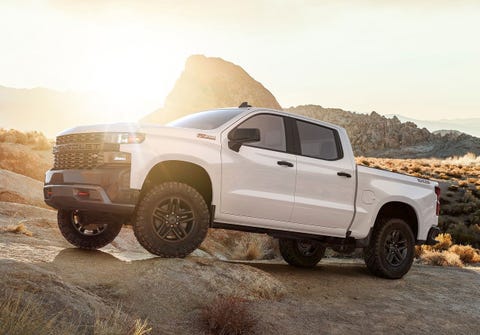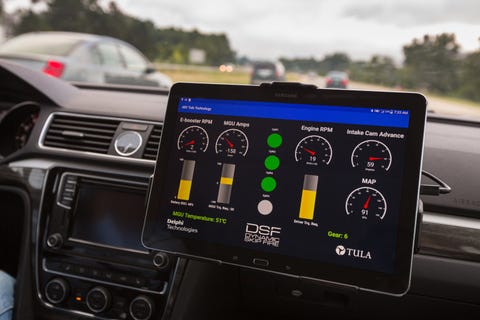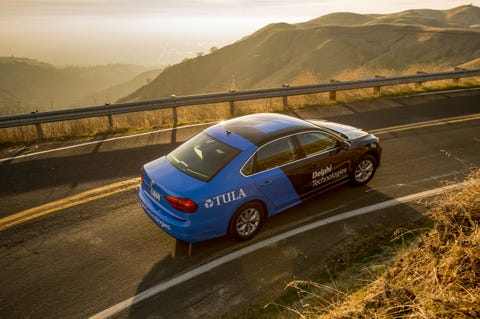How Smarter Cylinder-Skipping Will Make Gas Engines Better
Because sometimes your V8 doesn't need all that power.
By Matthew Jancer CHEVROLET
CHEVROLETFar from the car industry's heart in Detroit, Silicon Valley startup Tula Technology is gearing up for the first product launch of its 10-year history. In all that time, Tula has been working on one thing: Dynamic Skip Fire (DSF), a way to rapidly stop and restart engine cylinders individually based on the driving conditions of every individual moment.
“We're unique in Silicon Valley in that we are an internal combustion controls company,” says John Fuerst, Tula's senior vice president of engineering. Like several at Tula, Fuerst used to work at Delphi Technologies, a major parts supplier to the auto industry. But the promise of DSF was enough to lure him away from the traditional to the cutting edge.
Old Idea, New Tech

Dynamic Skip Fire monitor
JOHN F. MARTIN
It doesn't take all your engine's might to push your car all the time. In fact, 28 horsepower is all that's needed to move a 5,700-pound GMC Yukon Denali down the highway at 65 miles per hour, says Vijay Srinivasan, senior noise and vibration engineer at Tula. That's a fraction of the 6.2L V8's 403 horsepower, which means there's no need for the engine to run at peak capacity.
DSF's software determines how much torque the vehicle needs and—as often as 200 times per second on an eight-cylinder engine and 100 times per second on a four-cylinder—it shuts down every unnecessary cylinder in order to save fuel. Chugging steadily along in traffic, your 6.2L V8 can momentarily become a fuel-sipping 1.6L two-cylinder, and then later maybe a 3.9L five-cylinder, and then maybe a 0.8L one-cylinder. This year, DSF debuts on 2019 Chevrolet Silverados and GMC Sierras with 5.3L and 6.2L V8s.
“WE'RE UNIQUE IN SILICON VALLEY IN THAT WE ARE AN INTERNAL COMBUSTION CONTROLS COMPANY."
Of course, cylinder deactivation systems aren't new basic versions came around in the 2000s. But those simpler setups are binary: Either all the engine cylinders are running or half of them are, and there's not a lot of rapid switching back and forth. For example, V6 will shut down one row of cylinders, an I4 will shut down the inner two cylinders, and a V8 will shut down the inner cylinders on one row and the outer cylinders on the other row.
Those combinations in the older systems are based on which cylinders, running together, create the least engine vibration. There are a few exceptions. For example Ford's new-for-2018 EcoBoost 1.5L I3 can deactivate one cylinder, and Honda's J35Z2 3.5L V6 in 2008-2012 Accords could go from six to four to three cylinders, but only certain cylinders can be switched off. In rare situations, they can use other combinations that would create even less vibration or more accurately meet the power demands. But these computers don't have free reign to pick and choose any combination of cylinders they want.
That's where DSF differs. It can pick any combination of cylinders, calculating which ones pumping away together would create the least combined noise and vibration for that moment's driving conditions. For every 90 degrees that the crankshaft turns on a V8 or every 180 degrees on an I4, DSF is making a decision. How many cylinders to run is based upon how much torque the vehicle needs at that moment, and which cylinders to run depends on how they interact with each other to cause noise, vibration, and harshness.
Picking the Right Cylinders

TULA
If DSF decides it needs four cylinders' worth of power to cruise through town, it can also figure out that cylinders 1, 4, 7, and 8 is the smoothest-running combination at that moment. Under different circumstances it might choose four other cylinders, or more than four.
Accelerating under most conditions, DSF will fire all cylinders. Maintaining 70 miles per hour under light throttle, it could turn off all but one cylinder. Lift your foot off the throttle and all the cylinders deactivate.
Tula claims up to an 18 percent fuel efficiency boost, depending on the vehicle and situation. For eight-cylinder engines, the company's target is for DSF to reduce fuel consumption by about 15 percent. For four-cylinders, eight percent. Tula says there's little point in adapting DSF to anything with less than four cylinders.

2019 GMC Sierra
GMC
“We've done some development on three-cylinders,” says Fuerst, “but the benefit goes down as displacement and cylinder count go down. On a three-cylinder we'd be targeting about a three-percent fuel consumption benefit.”
General Motors' upcoming Chevy Silverado and GMC Sierra offer DSF on conventional gas-only powertrains. However, DSF was designed to play well with gasoline-electric hybrids and autonomous cars and across a broad range of engine layouts. Every OEM that licenses the DSF patent from Tula will be able to make proprietary tweaks to integrate it with their engine control systems.
“Early in the next decade, we expect several more launches,” Fuerst says. “We're working with to customers in all regions of the world, and we're looking at V8s and sixes and fours.”
The Uncertain Future of Internal Combustion

KARL NIELSEN
As as electrified cars become the norm, Tula still sees a long road ahead for the internal combustion engine. No one agrees on how long, but everyone agrees it'll be measured in decades. Even though the headlines say “Toyota predicts ICE dead by 2050,” Toyota's full quote read that 10 percent of new cars will be ICE/electric hybrids.
The nonprofit International Council on Clean Transportation says that's too optimistic. It estimates that, at most, 80 percent of new vehicles by 2050 will be electric, and that between now and then 3 billion ICE vehicles will be built. Mazda flat-out says it'll be selling ICE well beyond 2050.
No matter how long it lasts, automakers will continue throwing weight behind technologies like DSF to wring every ounce of efficiency out of internal combustion before it (fittingly) goes the way of the dinosaurs.
No comments:
Post a Comment